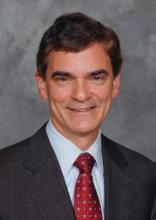User login
Emergency physician leaders are outraged over a new federal regulation that they say could drastically lower payments for out-of-network emergency services. The final regulation, which affirms interim regulations by the U.S. Department of Health & Human Services, allows health plans to use a vague methodology to calculate reimbursement for out-of-network emergency services.
The American College of Emergency Physicians has worked for years to have the rule’s language revised, said Dr. Jeffrey Bettinger, a member of ACEP’s reimbursement committee and founder of a health care business consulting firm in Pinecrest, Fla. “They released final regulations which not only kept worrisome language ... but it actually made it worse.”
The regulation, published Nov. 18 in the Federal Register, outlines patient protections under the Affordable Care Act, including how health plans must calculate coverage for out-of-network emergency services. The regulation states that a patient’s group health plan must reimburse out-of-network emergency services by paying the greatest of three possible (GOT) amounts:
• The median amount negotiated with in-network providers for the emergency service furnished.
• The amount for the emergency service calculated using the same method the plan generally uses to determine payments for out-of-network services (such as the usual, customary, and reasonable amount).
• The amount that would be paid under Medicare for the emergency service.
Under these options, the second choice is nearly always the greatest of the three amounts, and the last option – Medicare’s rate – is likely to be lowest, Dr. Bettinger said.
ACEP has long been concerned about the second option because it lacks specificity and essentially leaves it up to health insurance plans to establish a Medicare-related method to reimburse emergency physicians for out-of-network services. The college lobbied for government officials to require more transparency from insurers who chose to pay under option two – for instance, by tying their methods to a usual, customary, and reasonable database or another model that was academically validated, Dr. Bettinger said. The interim rule used the language, “such as the usual, customary, and reasonable charges,” rather than “amount” under option two. Under the final rule, the phrase “usual, customary, and reasonable amount,” is even more ambiguous than the proposed language, Dr. Bettinger said.
“It’s a nebulous term,” he said. “Its totally nontransparent. There’s no database that we know of that keeps track of what that number is. Honestly it’s interpreted by the insurance companies to dramatically lower the payments they are making for out-of-network emergency services.”
In the final regulation, HHS acknowledged concerns by health providers about the level of payment for out-of-network emergency services and the need for more transparency by insurers.
“The departments believe that this concern is addressed by our requirement that the amount be the greatest of the three amounts specified,” according to the regulation.
America’s Health Insurance Plans (AHIP), the national trade association for health insurers, declined to comment specifically about the final rule. However, AHIP spokesman Courtney Jay said that ACEP “isn’t addressing the amount patients are being charged for emergency services.” He noted a recent AHIP report finding that average billed charges submitted by out-of-network providers, including emergency physicians, far exceed Medicare reimbursement for the same service performed in the same geographic area. According to the September 2015 analysis, among 97 procedures studied, average out-of-network billed charges were from 118% to 1,382% of amounts paid by Medicare. High out-of-network charges impose significant burdens on consumers and result in high out-of-network expenses for patients due to balance billing by providers, according to AHIP.
The final regulation does not prohibit balance billing; however, if a patient resides in a state that bans balance billing, the “greatest of three” rule does not apply. Rather, emergency physicians in such states would be reimbursed based on the unique reimbursement method for out-of-network emergency services in their state. This could problematic for emergency physicians in states that prohibit balance billing, Dr. Bettinger said.
“Some states that have specific payment regulations won’t be impacted to a large degree,” he said. “Other states that have prohibitions have less clearly defined payment formulas. These states will be impacted by the final rule.”
ACEP is considering taking legal action against the government over the rule, said ACEP President Jay A. Kaplan.
“This new ruling will significantly benefit health insurance companies at the expense of physicians, because they know hospital emergency departments have a federal mandate to care for everyone, regardless of ability to pay,” Dr. Kaplan said in a statement. “They will continue to shift costs onto patients and medical providers, as well as shrink the number of doctors available in plans. Instead of requiring health plans to pay fairly, this ruling guarantees that insurance companies can pay whatever they want for emergency care. If history tells us anything, it’s that insurance companies prefer to pay as close to nothing as possible, while building their war chest for profits and litigation.”
HHS officials did not respond to requests for comment.
On Twitter @legal_med
Emergency physician leaders are outraged over a new federal regulation that they say could drastically lower payments for out-of-network emergency services. The final regulation, which affirms interim regulations by the U.S. Department of Health & Human Services, allows health plans to use a vague methodology to calculate reimbursement for out-of-network emergency services.
The American College of Emergency Physicians has worked for years to have the rule’s language revised, said Dr. Jeffrey Bettinger, a member of ACEP’s reimbursement committee and founder of a health care business consulting firm in Pinecrest, Fla. “They released final regulations which not only kept worrisome language ... but it actually made it worse.”
The regulation, published Nov. 18 in the Federal Register, outlines patient protections under the Affordable Care Act, including how health plans must calculate coverage for out-of-network emergency services. The regulation states that a patient’s group health plan must reimburse out-of-network emergency services by paying the greatest of three possible (GOT) amounts:
• The median amount negotiated with in-network providers for the emergency service furnished.
• The amount for the emergency service calculated using the same method the plan generally uses to determine payments for out-of-network services (such as the usual, customary, and reasonable amount).
• The amount that would be paid under Medicare for the emergency service.
Under these options, the second choice is nearly always the greatest of the three amounts, and the last option – Medicare’s rate – is likely to be lowest, Dr. Bettinger said.
ACEP has long been concerned about the second option because it lacks specificity and essentially leaves it up to health insurance plans to establish a Medicare-related method to reimburse emergency physicians for out-of-network services. The college lobbied for government officials to require more transparency from insurers who chose to pay under option two – for instance, by tying their methods to a usual, customary, and reasonable database or another model that was academically validated, Dr. Bettinger said. The interim rule used the language, “such as the usual, customary, and reasonable charges,” rather than “amount” under option two. Under the final rule, the phrase “usual, customary, and reasonable amount,” is even more ambiguous than the proposed language, Dr. Bettinger said.
“It’s a nebulous term,” he said. “Its totally nontransparent. There’s no database that we know of that keeps track of what that number is. Honestly it’s interpreted by the insurance companies to dramatically lower the payments they are making for out-of-network emergency services.”
In the final regulation, HHS acknowledged concerns by health providers about the level of payment for out-of-network emergency services and the need for more transparency by insurers.
“The departments believe that this concern is addressed by our requirement that the amount be the greatest of the three amounts specified,” according to the regulation.
America’s Health Insurance Plans (AHIP), the national trade association for health insurers, declined to comment specifically about the final rule. However, AHIP spokesman Courtney Jay said that ACEP “isn’t addressing the amount patients are being charged for emergency services.” He noted a recent AHIP report finding that average billed charges submitted by out-of-network providers, including emergency physicians, far exceed Medicare reimbursement for the same service performed in the same geographic area. According to the September 2015 analysis, among 97 procedures studied, average out-of-network billed charges were from 118% to 1,382% of amounts paid by Medicare. High out-of-network charges impose significant burdens on consumers and result in high out-of-network expenses for patients due to balance billing by providers, according to AHIP.
The final regulation does not prohibit balance billing; however, if a patient resides in a state that bans balance billing, the “greatest of three” rule does not apply. Rather, emergency physicians in such states would be reimbursed based on the unique reimbursement method for out-of-network emergency services in their state. This could problematic for emergency physicians in states that prohibit balance billing, Dr. Bettinger said.
“Some states that have specific payment regulations won’t be impacted to a large degree,” he said. “Other states that have prohibitions have less clearly defined payment formulas. These states will be impacted by the final rule.”
ACEP is considering taking legal action against the government over the rule, said ACEP President Jay A. Kaplan.
“This new ruling will significantly benefit health insurance companies at the expense of physicians, because they know hospital emergency departments have a federal mandate to care for everyone, regardless of ability to pay,” Dr. Kaplan said in a statement. “They will continue to shift costs onto patients and medical providers, as well as shrink the number of doctors available in plans. Instead of requiring health plans to pay fairly, this ruling guarantees that insurance companies can pay whatever they want for emergency care. If history tells us anything, it’s that insurance companies prefer to pay as close to nothing as possible, while building their war chest for profits and litigation.”
HHS officials did not respond to requests for comment.
On Twitter @legal_med
Emergency physician leaders are outraged over a new federal regulation that they say could drastically lower payments for out-of-network emergency services. The final regulation, which affirms interim regulations by the U.S. Department of Health & Human Services, allows health plans to use a vague methodology to calculate reimbursement for out-of-network emergency services.
The American College of Emergency Physicians has worked for years to have the rule’s language revised, said Dr. Jeffrey Bettinger, a member of ACEP’s reimbursement committee and founder of a health care business consulting firm in Pinecrest, Fla. “They released final regulations which not only kept worrisome language ... but it actually made it worse.”
The regulation, published Nov. 18 in the Federal Register, outlines patient protections under the Affordable Care Act, including how health plans must calculate coverage for out-of-network emergency services. The regulation states that a patient’s group health plan must reimburse out-of-network emergency services by paying the greatest of three possible (GOT) amounts:
• The median amount negotiated with in-network providers for the emergency service furnished.
• The amount for the emergency service calculated using the same method the plan generally uses to determine payments for out-of-network services (such as the usual, customary, and reasonable amount).
• The amount that would be paid under Medicare for the emergency service.
Under these options, the second choice is nearly always the greatest of the three amounts, and the last option – Medicare’s rate – is likely to be lowest, Dr. Bettinger said.
ACEP has long been concerned about the second option because it lacks specificity and essentially leaves it up to health insurance plans to establish a Medicare-related method to reimburse emergency physicians for out-of-network services. The college lobbied for government officials to require more transparency from insurers who chose to pay under option two – for instance, by tying their methods to a usual, customary, and reasonable database or another model that was academically validated, Dr. Bettinger said. The interim rule used the language, “such as the usual, customary, and reasonable charges,” rather than “amount” under option two. Under the final rule, the phrase “usual, customary, and reasonable amount,” is even more ambiguous than the proposed language, Dr. Bettinger said.
“It’s a nebulous term,” he said. “Its totally nontransparent. There’s no database that we know of that keeps track of what that number is. Honestly it’s interpreted by the insurance companies to dramatically lower the payments they are making for out-of-network emergency services.”
In the final regulation, HHS acknowledged concerns by health providers about the level of payment for out-of-network emergency services and the need for more transparency by insurers.
“The departments believe that this concern is addressed by our requirement that the amount be the greatest of the three amounts specified,” according to the regulation.
America’s Health Insurance Plans (AHIP), the national trade association for health insurers, declined to comment specifically about the final rule. However, AHIP spokesman Courtney Jay said that ACEP “isn’t addressing the amount patients are being charged for emergency services.” He noted a recent AHIP report finding that average billed charges submitted by out-of-network providers, including emergency physicians, far exceed Medicare reimbursement for the same service performed in the same geographic area. According to the September 2015 analysis, among 97 procedures studied, average out-of-network billed charges were from 118% to 1,382% of amounts paid by Medicare. High out-of-network charges impose significant burdens on consumers and result in high out-of-network expenses for patients due to balance billing by providers, according to AHIP.
The final regulation does not prohibit balance billing; however, if a patient resides in a state that bans balance billing, the “greatest of three” rule does not apply. Rather, emergency physicians in such states would be reimbursed based on the unique reimbursement method for out-of-network emergency services in their state. This could problematic for emergency physicians in states that prohibit balance billing, Dr. Bettinger said.
“Some states that have specific payment regulations won’t be impacted to a large degree,” he said. “Other states that have prohibitions have less clearly defined payment formulas. These states will be impacted by the final rule.”
ACEP is considering taking legal action against the government over the rule, said ACEP President Jay A. Kaplan.
“This new ruling will significantly benefit health insurance companies at the expense of physicians, because they know hospital emergency departments have a federal mandate to care for everyone, regardless of ability to pay,” Dr. Kaplan said in a statement. “They will continue to shift costs onto patients and medical providers, as well as shrink the number of doctors available in plans. Instead of requiring health plans to pay fairly, this ruling guarantees that insurance companies can pay whatever they want for emergency care. If history tells us anything, it’s that insurance companies prefer to pay as close to nothing as possible, while building their war chest for profits and litigation.”
HHS officials did not respond to requests for comment.
On Twitter @legal_med


